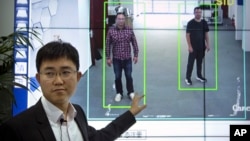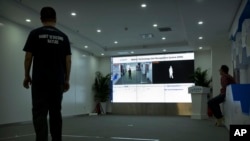China is developing a system that recognizes individuals by their body shape and walking movements.
Systems that recognize human faces are already being used to identify people in crowds or as a secure way to unlock personal devices.
The new system, known as “gait recognition,” is already being used by police on the streets of Beijing and Shanghai. The Chinese technology company Watrix developed the system. The company announced last month that it had raised $14.5 million to speed up the development and sale of the technology.
The system works in a similar way to face recognition. Cameras capture video of people in public places. Then, machines powered by artificial intelligence (AI) examine and study the video.
Facial recognition systems identify the shapes and expressions on a person’s face to identify them. Gait recognition uses a person’s body shape and their way of walking to identify them. The system records a person’s shape and movements and then creates a model of the way they walk.
Huang Yongzhen is a former researcher who co-founded Watrix in 2016. He told the Associated Press his system can identify people from up to 50 meters away. It is designed to work even when a person’s face is covered or hidden. Successful facial recognition usually requires clear, close-up images of a person’s face.
Currently, the Watrix system is not able to identify people in real-time. Users have to enter video into the system, which then takes about 10 minutes to process each hour of video.
Huang says his gait recognition system is correct 94 percent of the time. This is below the success rate of many face recognition systems. But he says the system can still be helpful to police and for other commercial purposes. He also believes the system can be effective when used together with face recognition.
“You don’t need people’s cooperation for us to be able to recognize their identity,” Huang told the AP. “People still don’t recognize they can be recognized by their gait, whereas everybody knows you can be recognized by your face,” he added.
He said the system would not easily be misled by a person changing their usual way of walking or other body movements. This is because the AI system is designed to examine all movements over the entire body. “We believe you are totally unique in the way you walk,” Huang said.
Gait recognition is not new. The technology has been researched by scientists in Japan and Britain and by U.S. defense officials for about 10 years. But attempts to sell the technology have been slow.
One of the reasons the technology has not developed further is because the systems are more complex than facial recognition.
Mark Nixon is a leading expert on gait recognition at Britain’s University of Southampton. He told the AP the technology requires bigger computers. “Because you need a sequence of images rather than a single image,” he said.
Security officials in China’s far-western province of Xinjiang have reportedly expressed interest in the system. Muslim ethnic minorities in the province are already subject to intense government surveillance and control.
Shi Shusi is a Chinese writer and commentator. He told the AP he is not surprised that the technology would launch in China before the rest of the world. He said this is because of the Chinese government’s use of social control methods.
“Using biometric recognition to maintain social stability and manage society is an unstoppable trend,” Shi said. He added: “It’s great business.”
I’m Bryan Lynn.
Bryan Lynn wrote this story for VOA Learning English, based on report from the Associated Press and online sources. Mario Ritter was the editor.
What are your feelings about facial and gait recognition technology? Write to us in the Comments section, and visit our Facebook page.
_______________________________________________________________
________________________________________________________________
Words in This Story
gait – n. the way a person walks and moves the body
artificial intelligence – n. ability of a machine to use and analyze data in an attempt to reproduce human behavior
commercial – adj. related to buying and selling things
sequence – n. a series of related things
biometric – adj. involving the application of statistical analysis to biological data
stability – n. the quality of not being likely to change or move
trend – n. a way of behaving, proceeding, etc., that is developing and becoming more common












